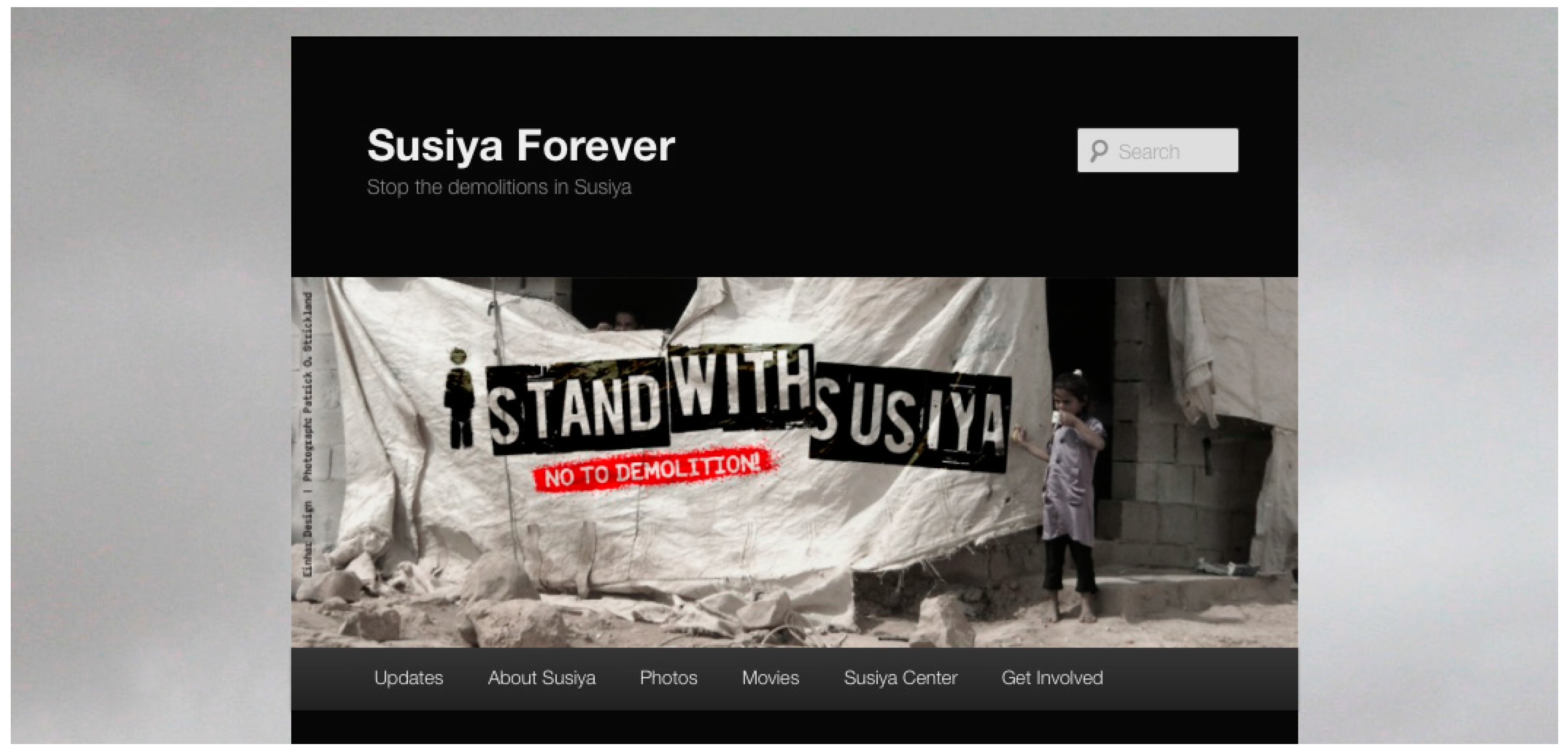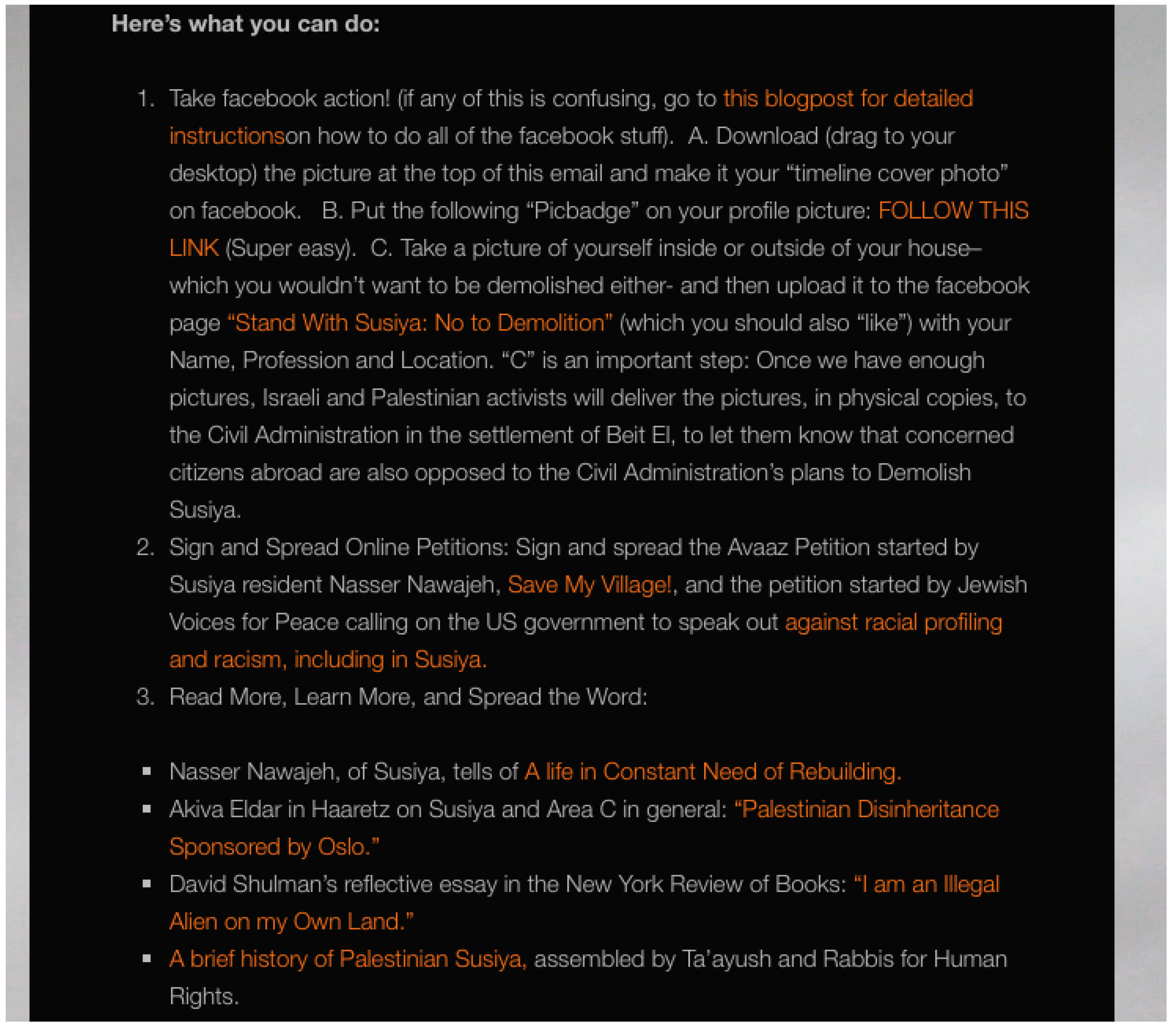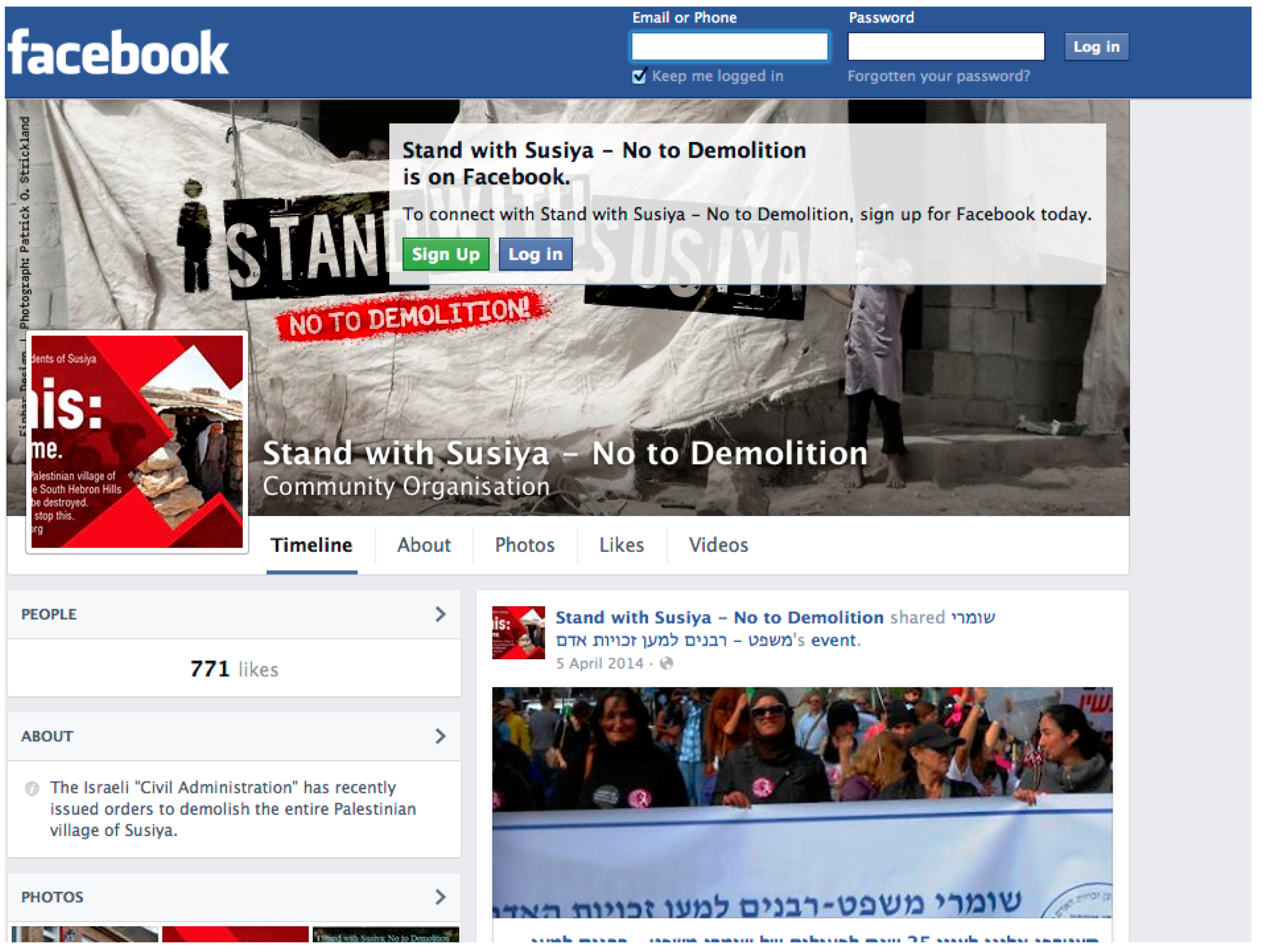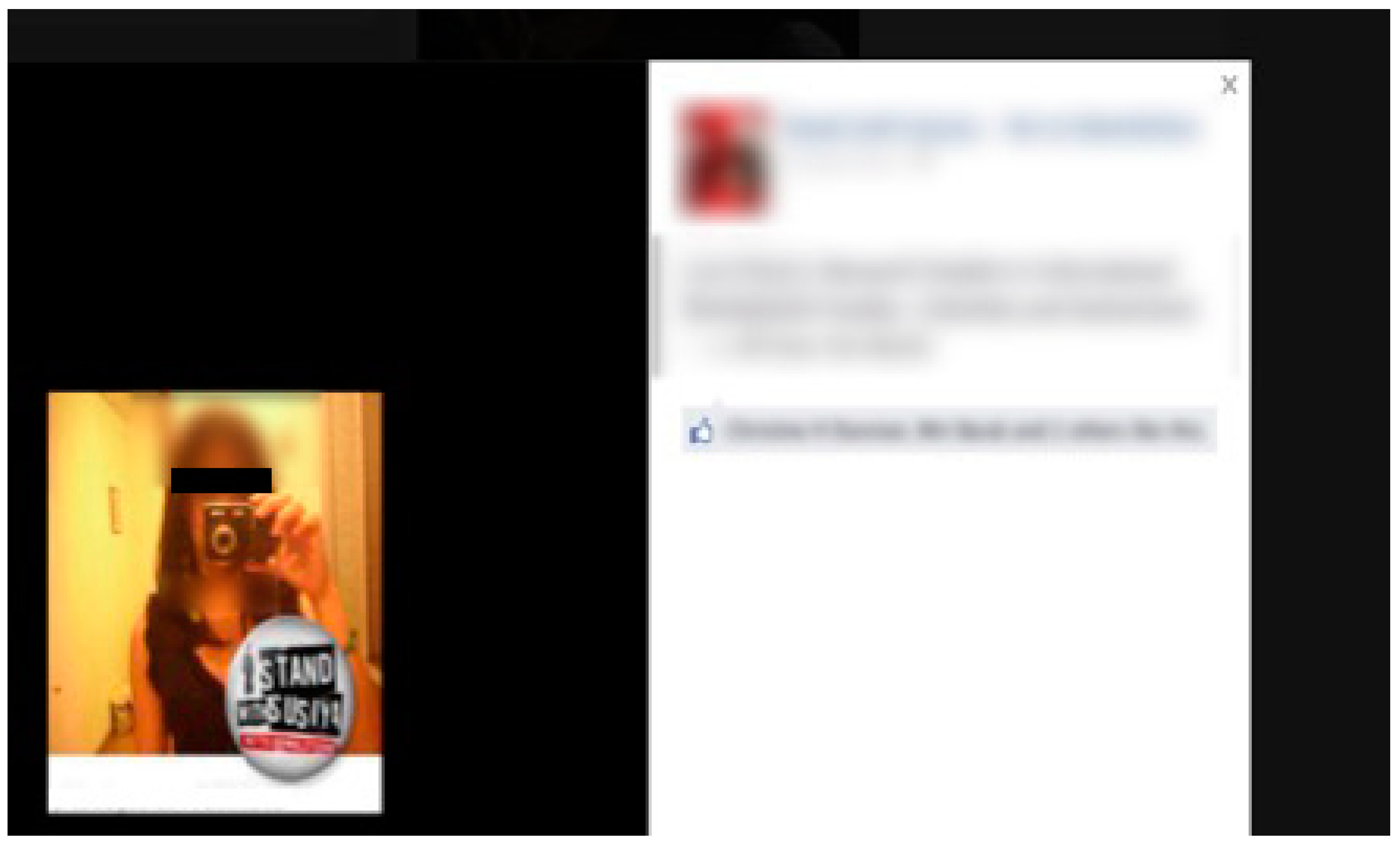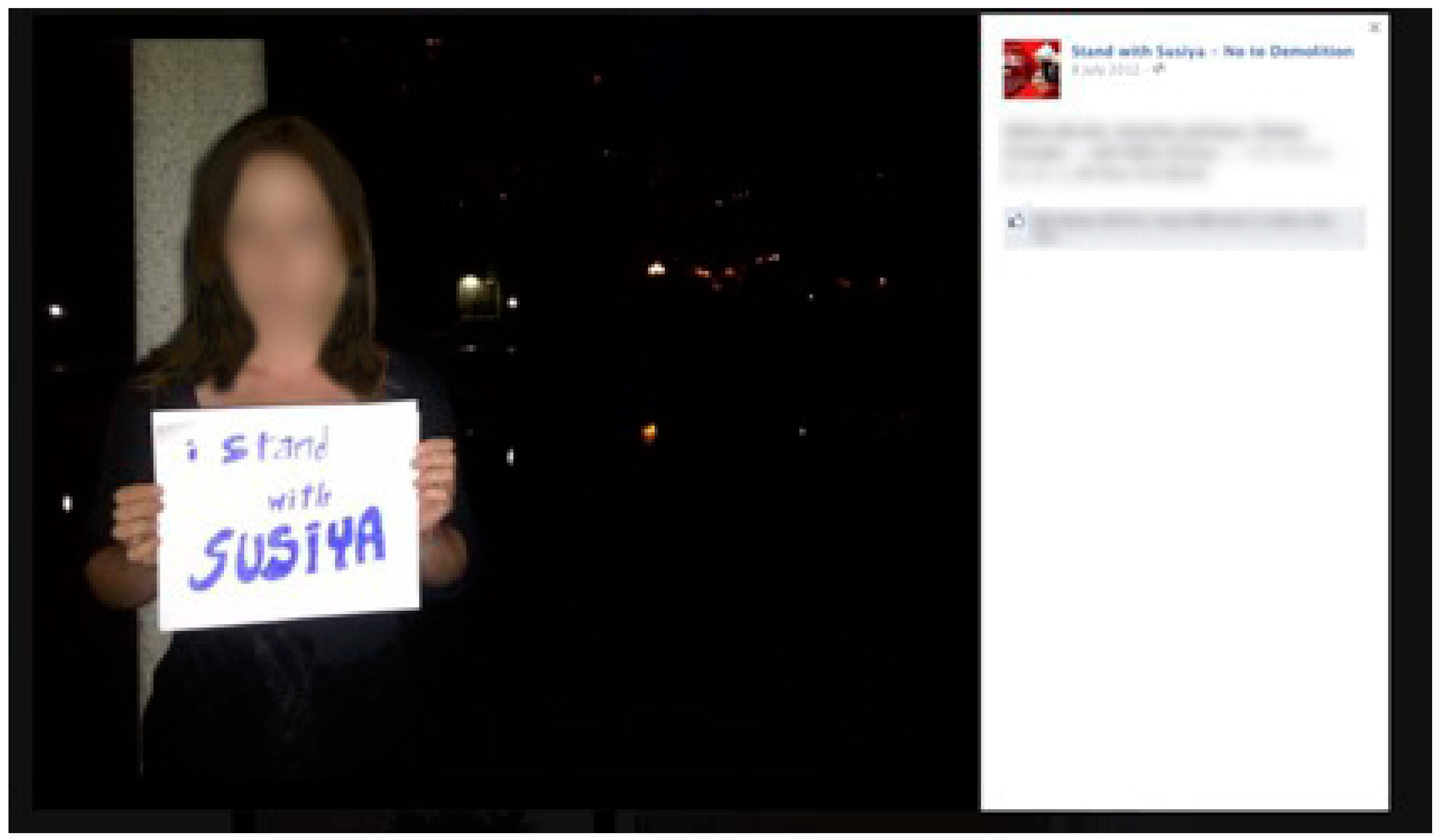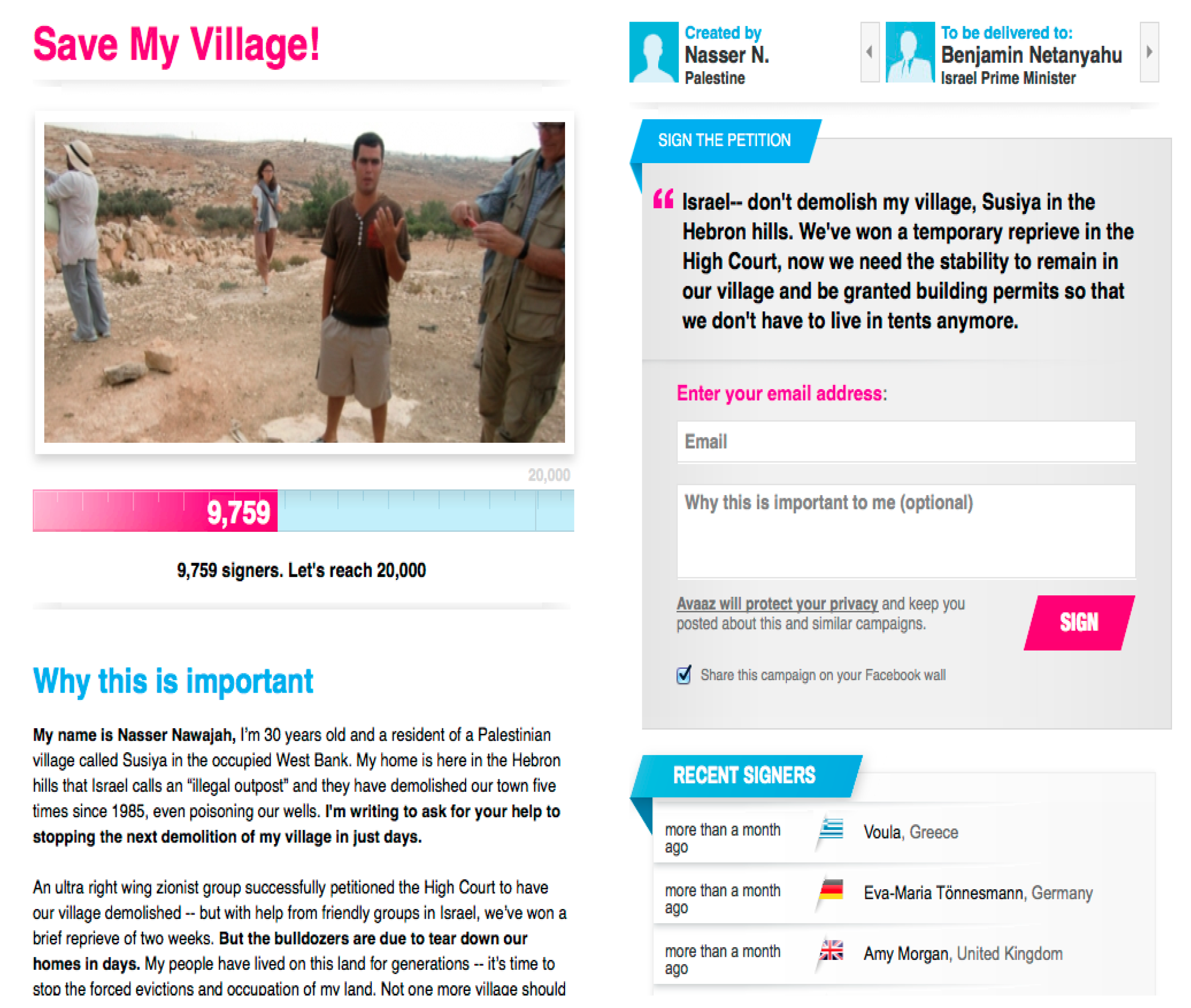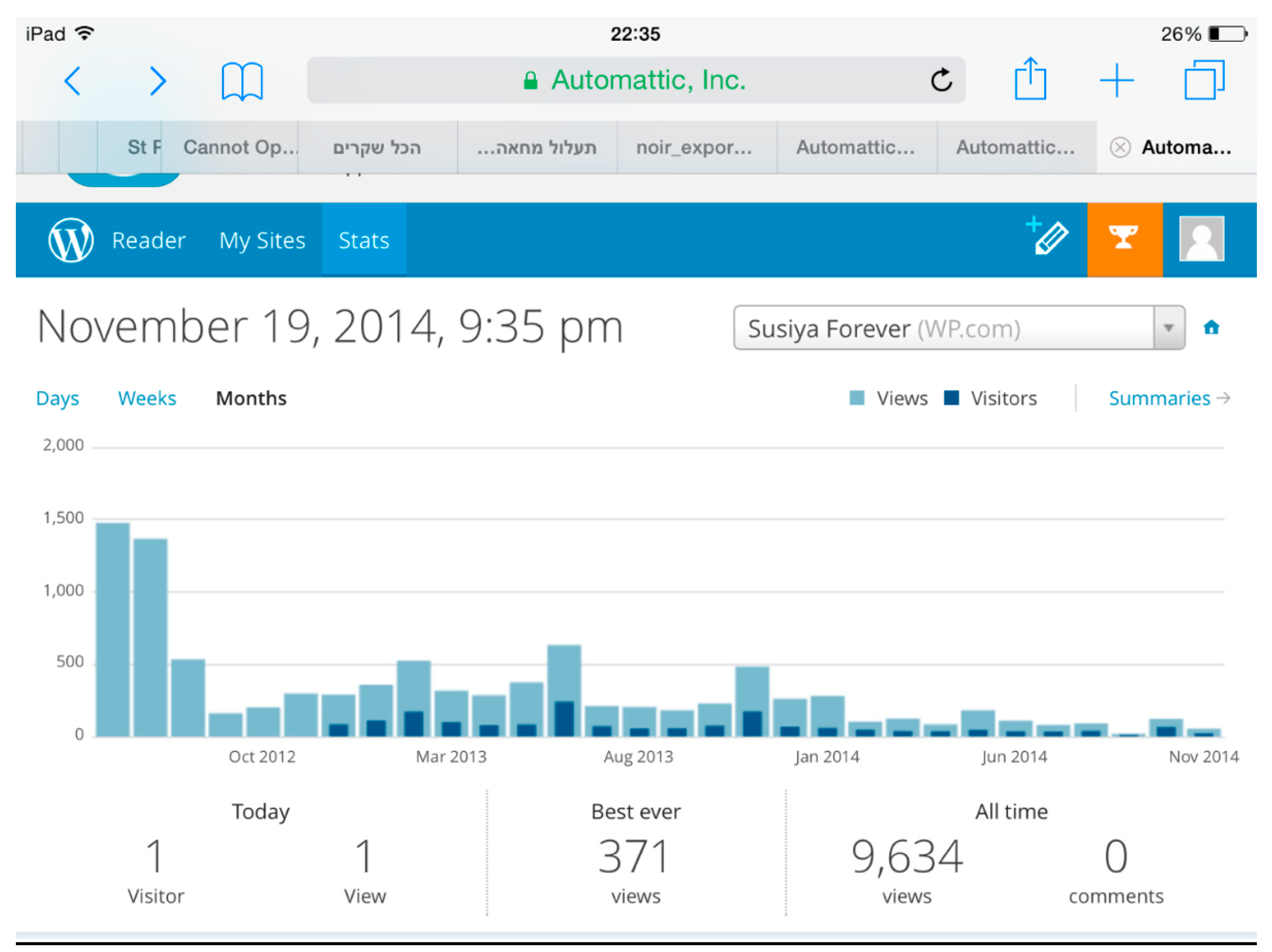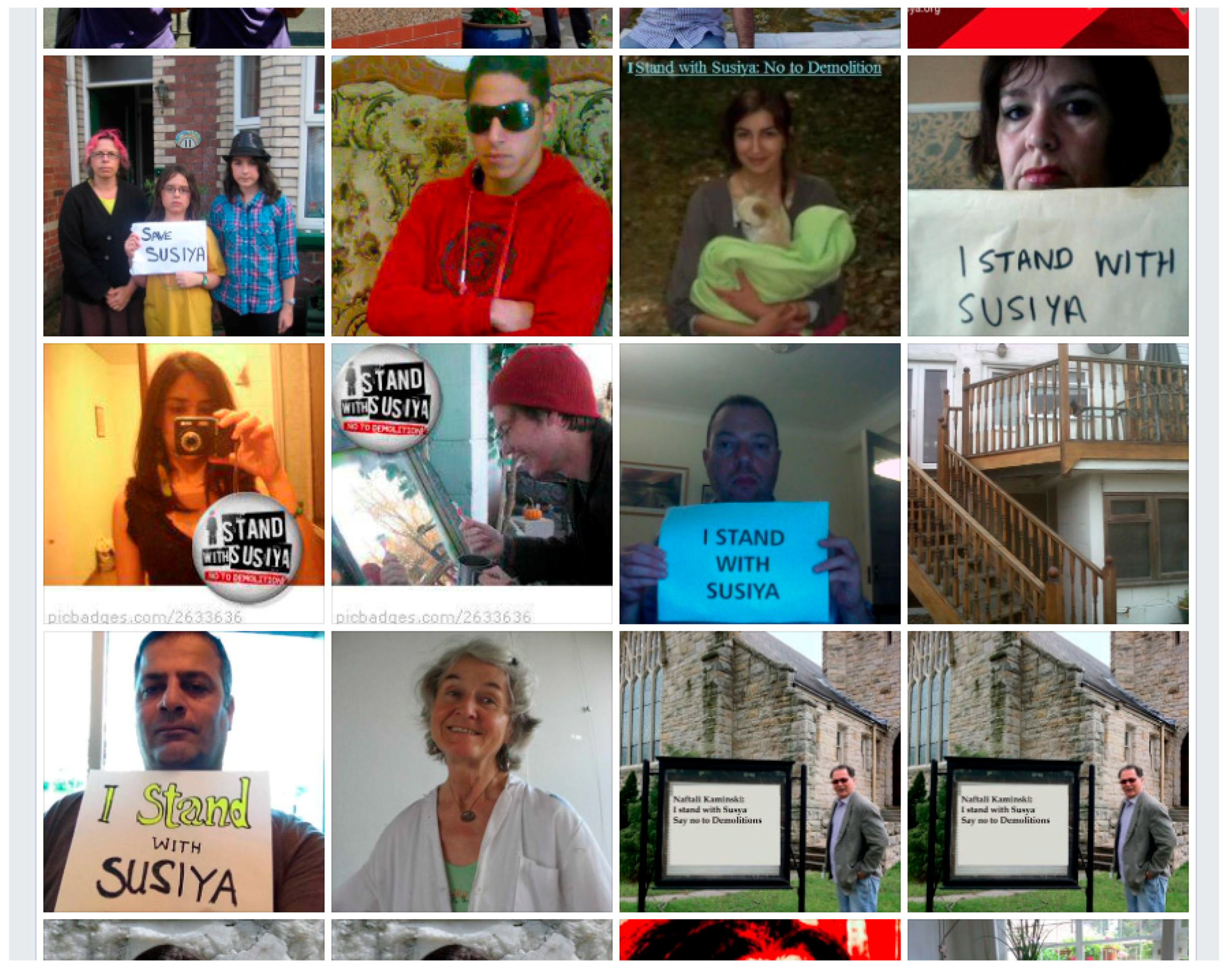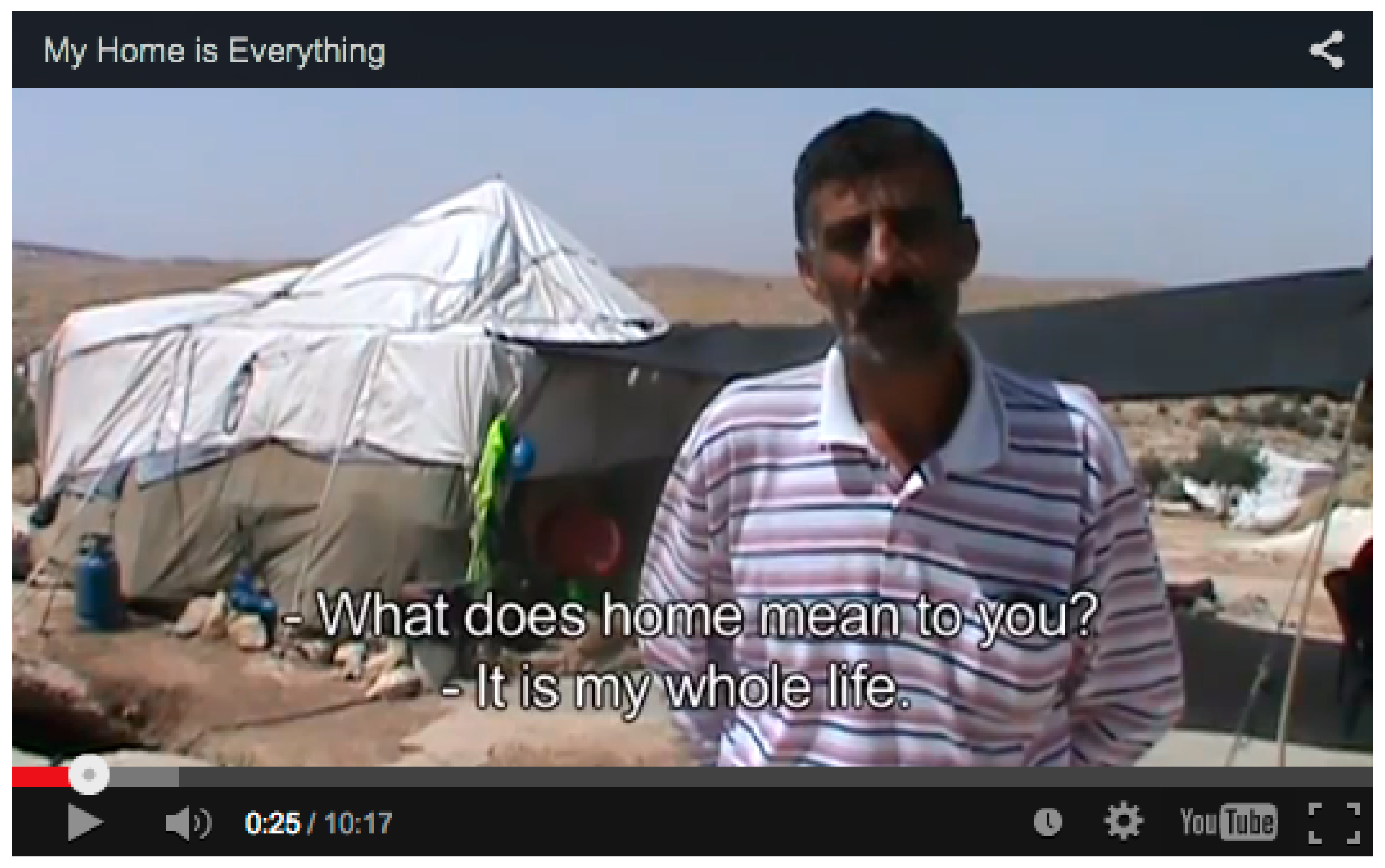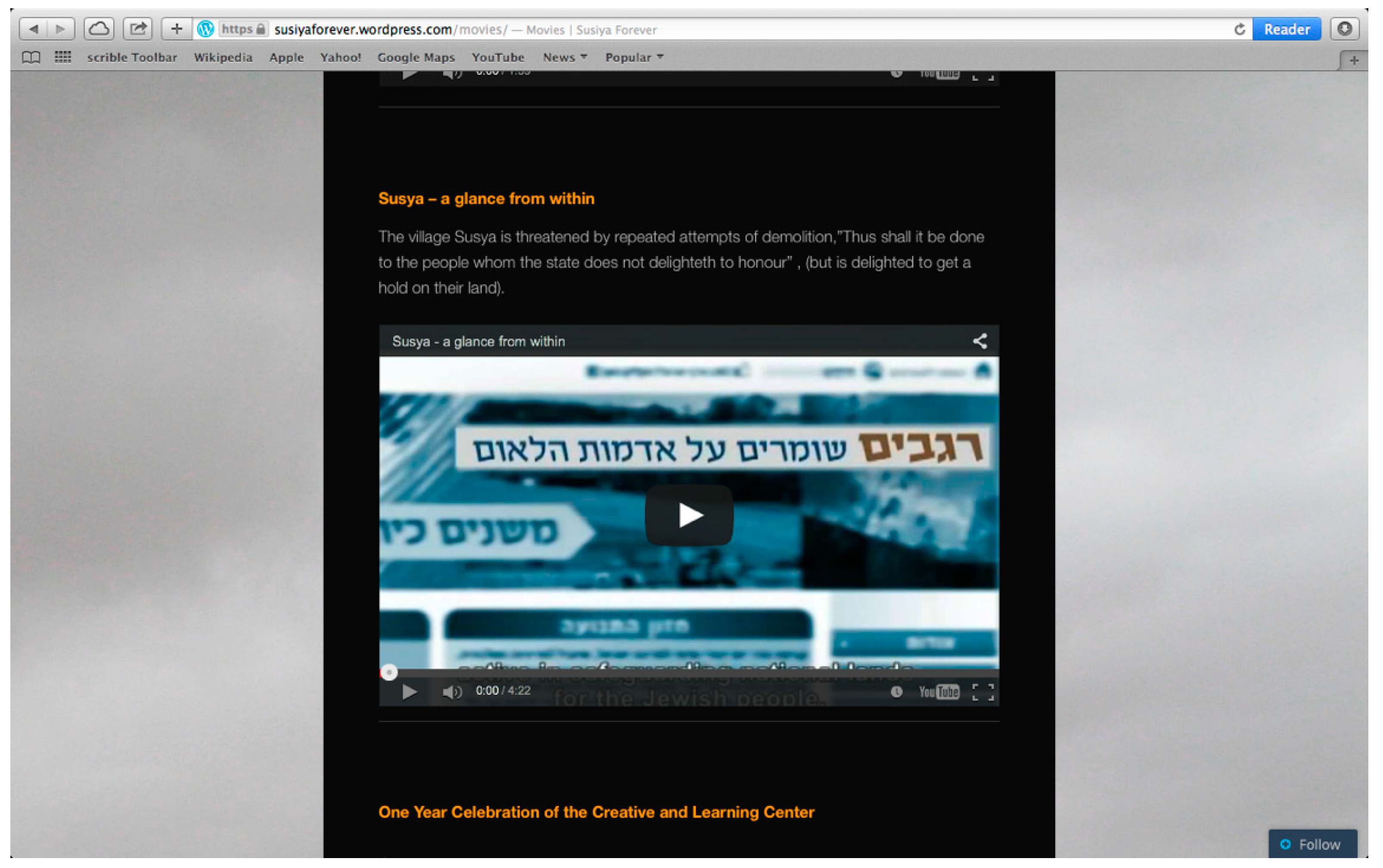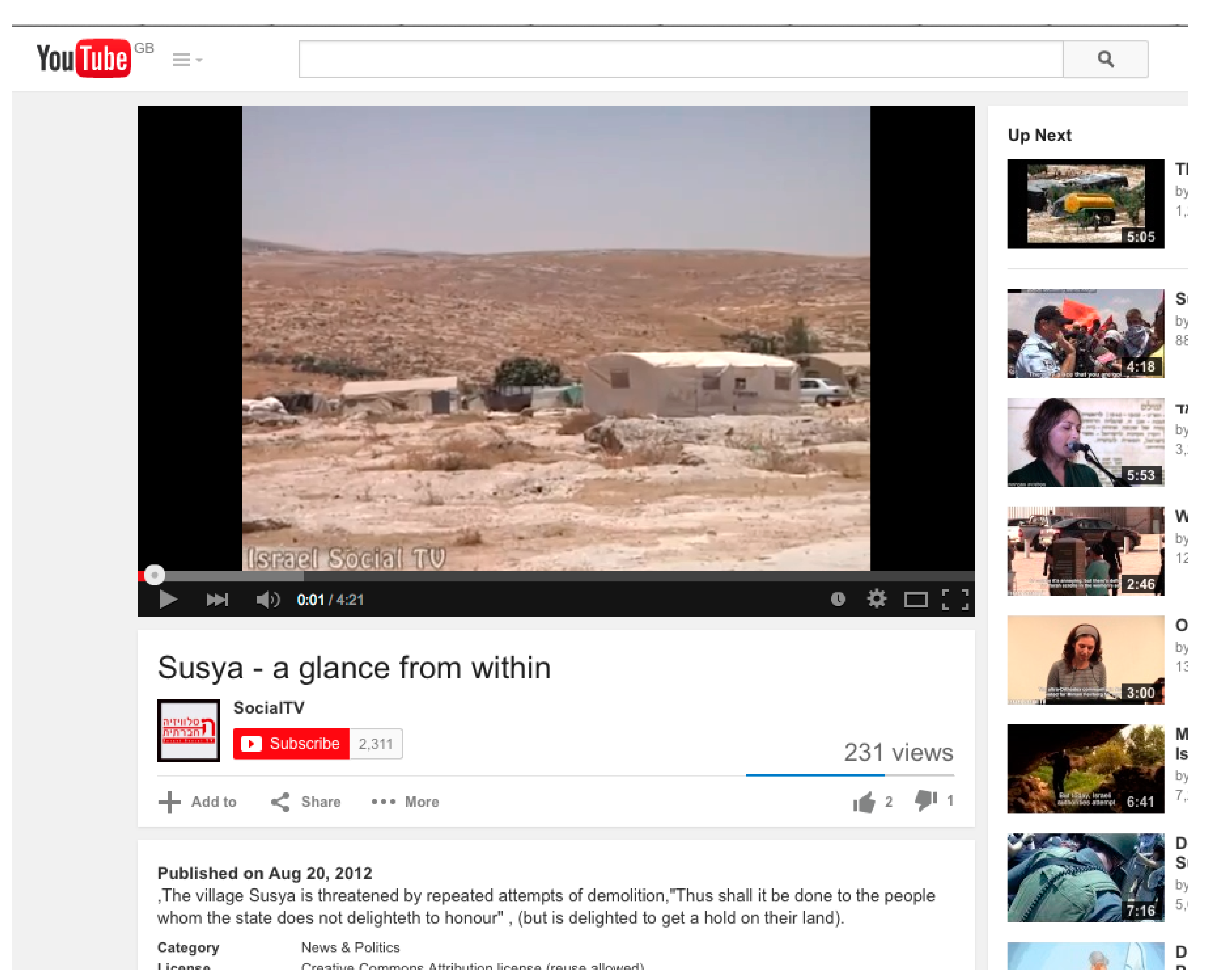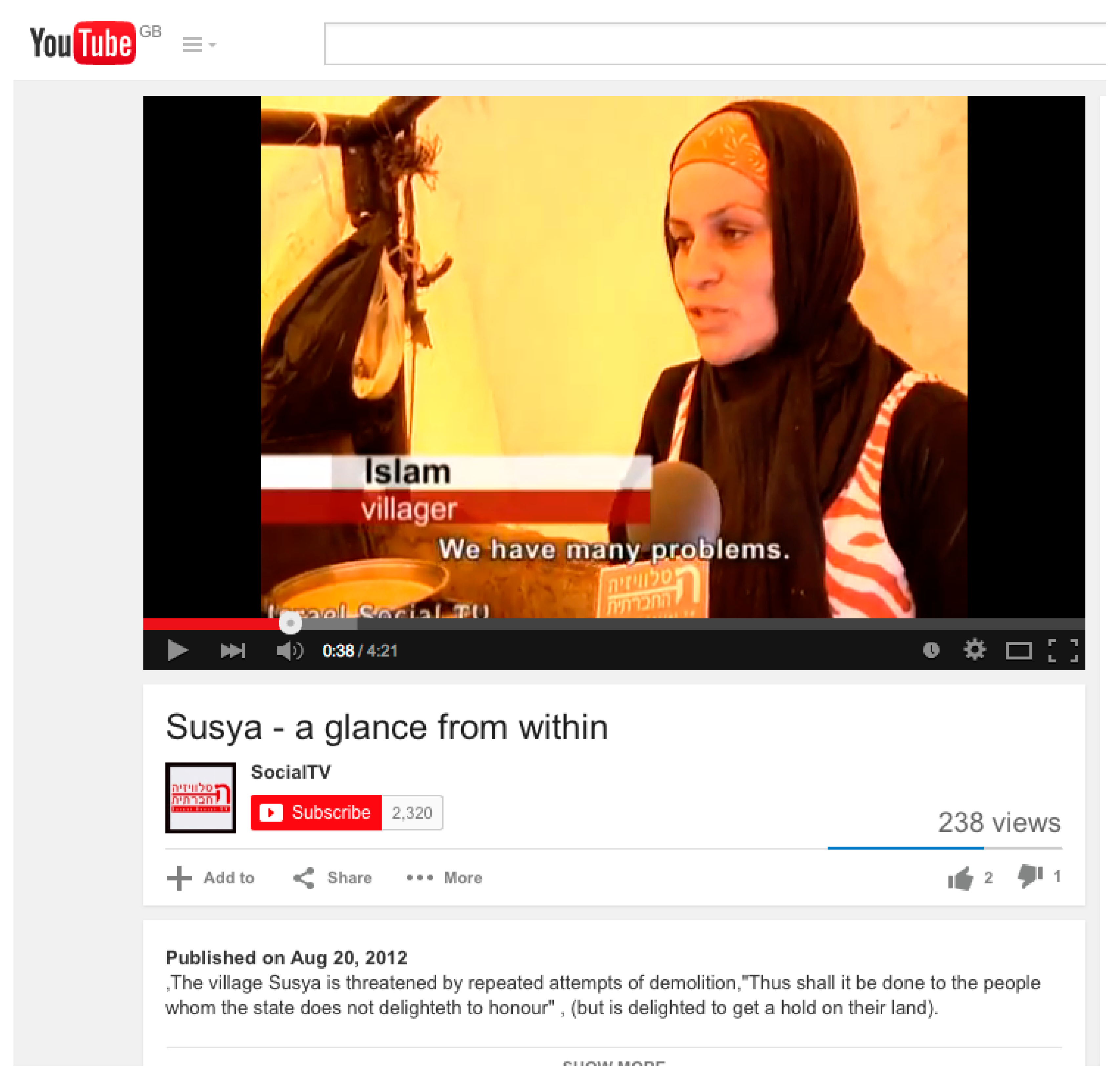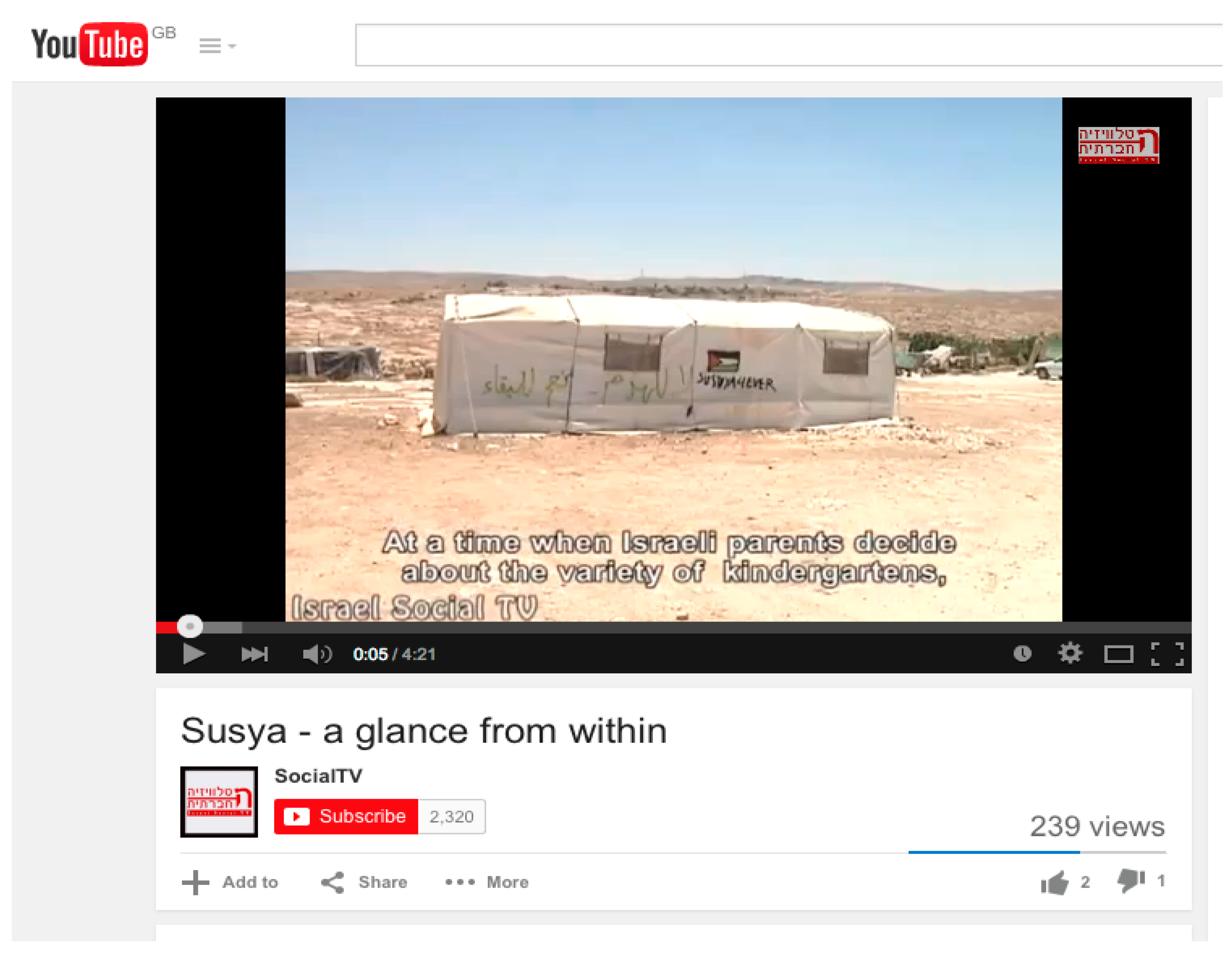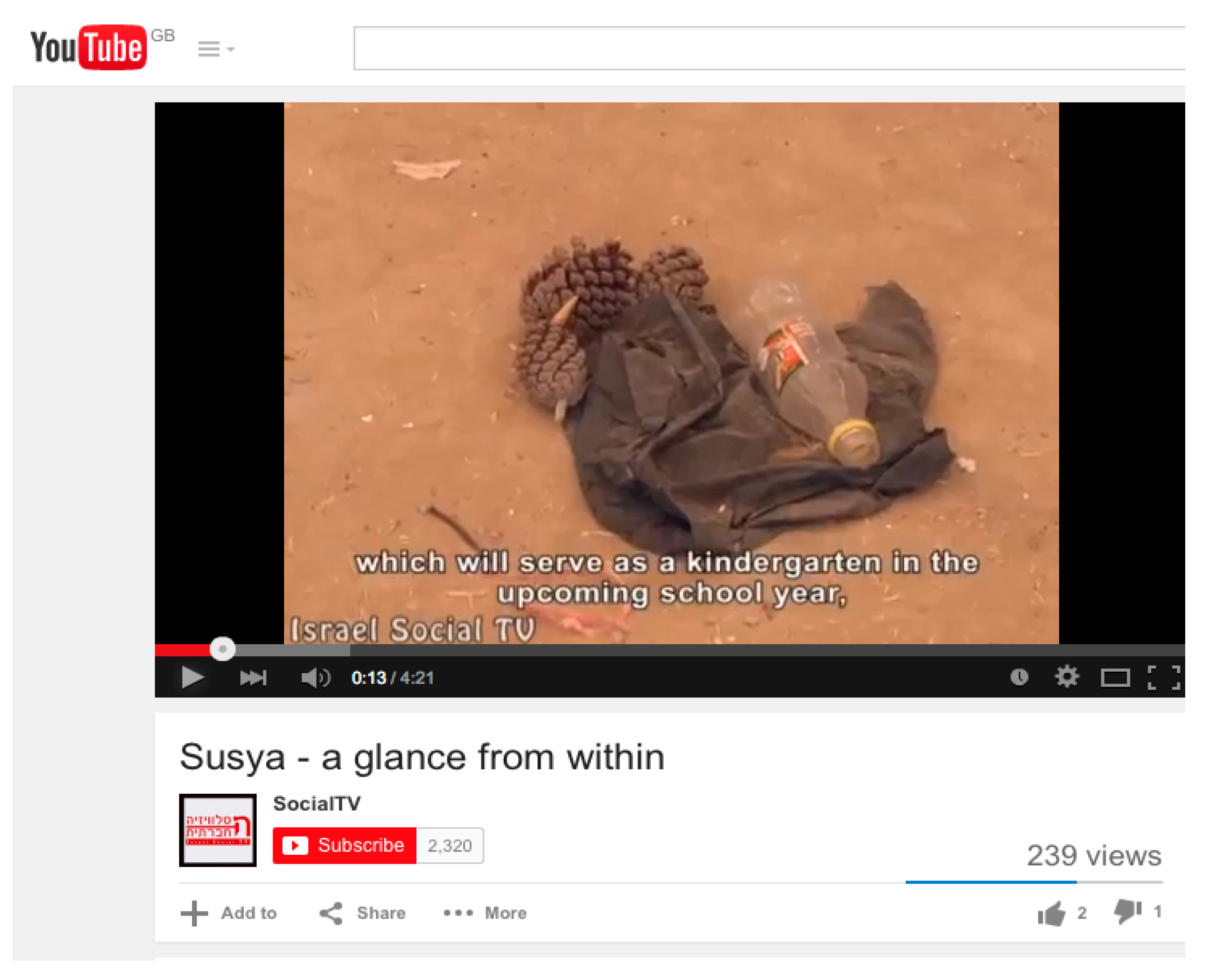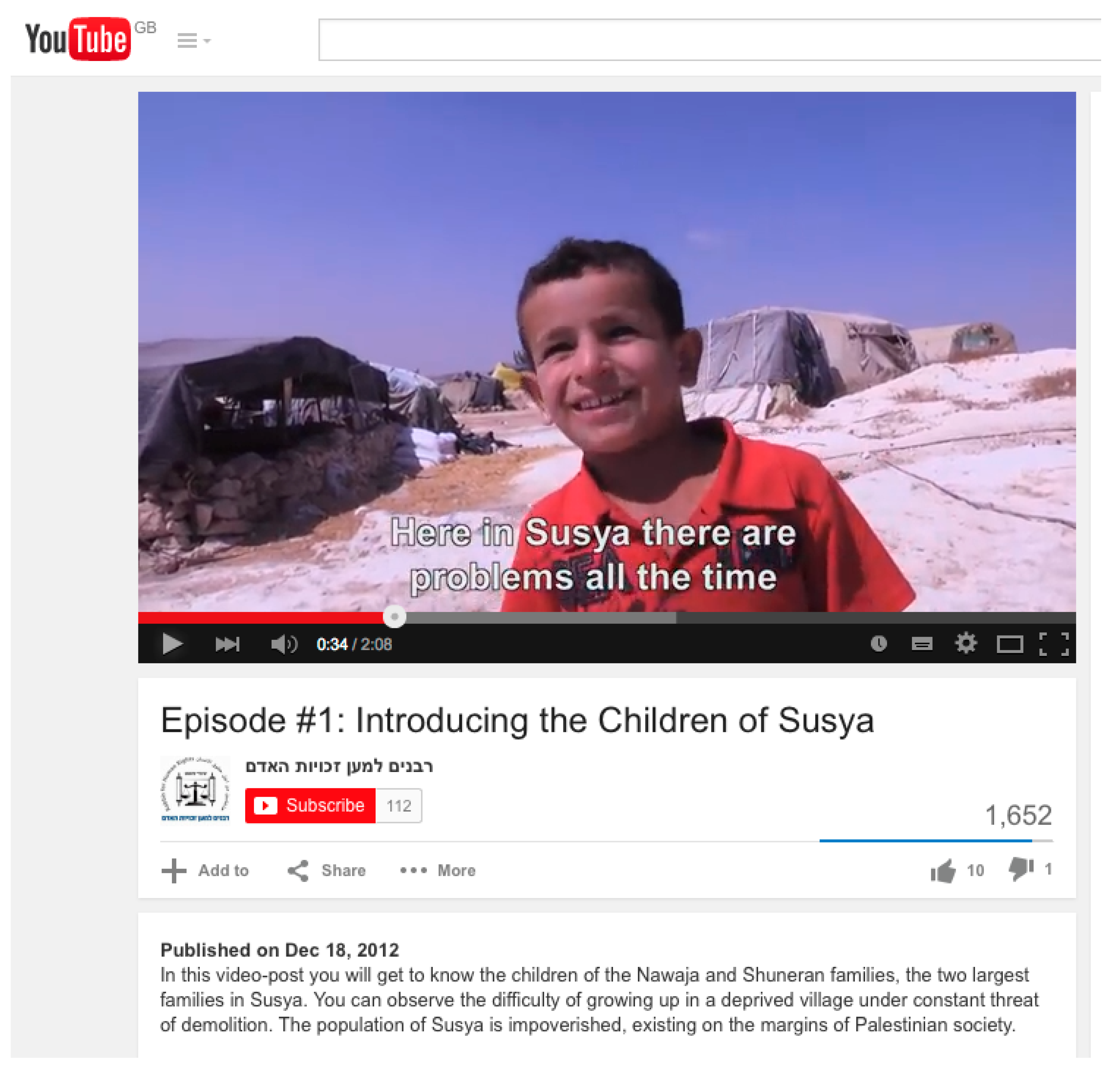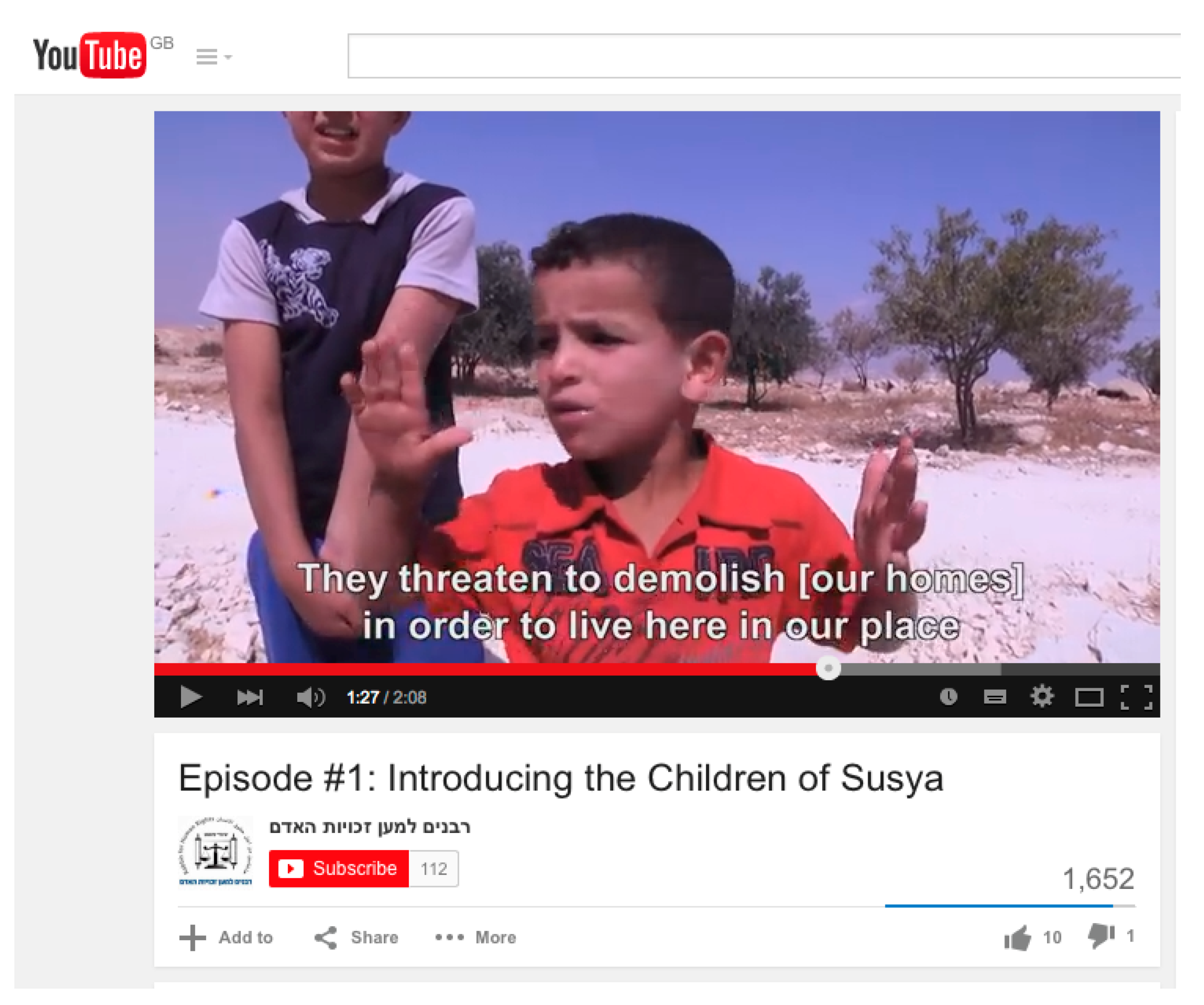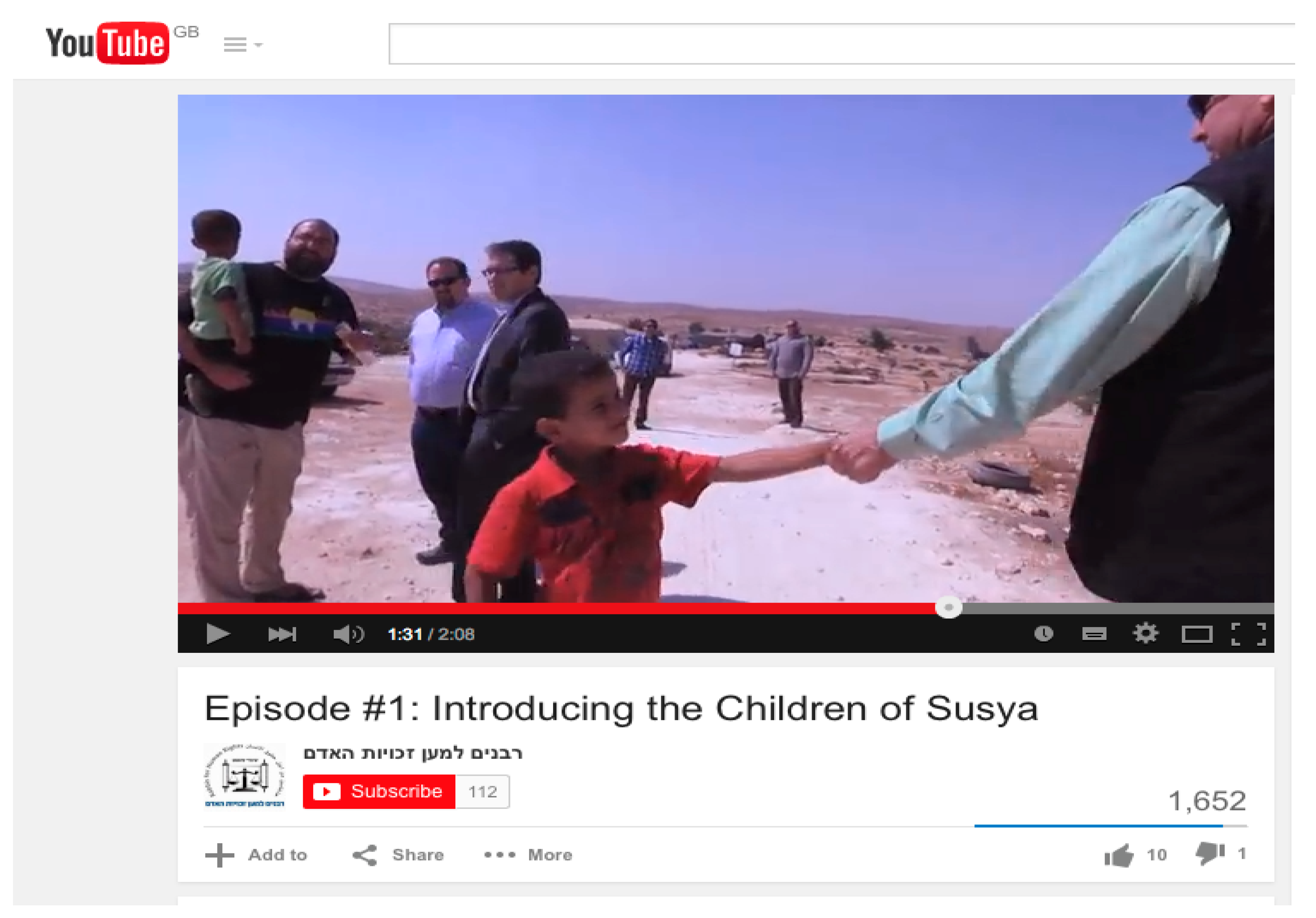Focusing on the Palestinian village of Susiya, a farm community located in the Southern Hebron Hills of the West Bank, this article explores the varied ways in which villagers, Human Rights Organisations (HRO) and a Non-Governmental Organisation (NGO) employed a range of visual responses to a village wide demolition order, issued by the Israeli authority on Tuesday 12 June 2012. Just one aspect of an extended study into the villager’s steadfastness and efforts to build and maintain ‘networks of solidarity’ (
Bishara 2010), this essay pays particular attention to what Gil Hochberg calls the uneven ‘visual configurations’ through which the Israeli-Palestinian conflict appears (5:2015). To explore such configurations requires us to look anew at the way in which the conflict and its effects have come to be seen. We must rethink how it appears and how we come to see it. To do so, we must firstly ‘not take the conflict as our point of departure’, including its media representation, but instead, ‘explore the very making of the conflict by focusing on the
distribution (emphasis added) of the visual (5:2015) to ask, who comes into visibility and how’. In this particular case, the management and distribution of human rights appeals.
The Israeli military and administrative occupation over Palestinian land and its inhabitants produces a number of asymmetries that include the distribution of visual rights that are intrinsically linked to power. Palestinians both in and outside the Occupied Palestinian Territories (OPT) are, to some extent, caught in a visual trap that offers little political economy. ‘Simultaneously in and out of view, seen and unseen, noticed and overlooked, recorded in the finest detail and yet absolutely indiscernible from its surroundings’ (
Paul 2018), the struggle over visibility can be counted as one of the main aspects of Palestinian life, along with ‘dispossession, exile, dispersion, disenfranchisement and the widespread and stubborn resistance to these travails’ (
Said 1992).
Visibility (the conditions of being seen), vision (seeing or failing to see) and visuality (the distribution of power determining who can see what and how) never reflect a single coherent or predetermined political function (
Hochberg 2015, p. 164). These processes are always contested and often unevenly distributed. Within the context of the Israeli Occupation, these configurations can be drawn from a general historical and ideological position of willful denial that has manifested into socio-political and technical arrangements of erasure and blocking. While the latter includes walling, the introduction of checkpoints and Israeli only by-pass routes within the West Bank, the former, can be traced back to the oft-quoted Zionist phrase, ‘a land without a people for a people without a land’; the etymology of which was first used by Scottish Christian Zionist, Alexander Keith advocating on behalf of the diasporian Jewry during the late 19th century.
1 Rooted in biblical and historical discourse, such failures and refusals to see or recognise the political agency of native Palestinian inhabitants is one such configuration that shapes Palestinian visibility. The village of Susiya and the nineteen neighbouring
khirbehs2 that make up a remote population of Palestinian herders and farmers, live under full Israeli military and administrative control. Known as Bedouins, a name derived from the Arabic word
Bedu meaning ‘inhabitant of the desert’ (
Shulman 2007, p. 15) these nomadic farmers have lived and worked on mountains and hills since the 1830s and, along with other Bedouin communities, constitute roughly 63% of the West Bank population. More specifically, the Bedouin of Susiya are situated within a topography in which 99% of the land is excluded from Palestinian use; the villagers and the neighbouring Palestinian communities are denied basic amenities such as water, electricity, shelter and have limited movement. Additionally, they lack permanent residency, citizenry rights and building permits under the current Israeli administration. Without the ability to fully participate in a system that denies their participation in it, the village of Susiya, like many of its neighbours in the Hebron Hills, is characterised by the paradoxical optics of non-recognition and surveillance—the local authorities know they are present but do not recognise them. The Israeli government knows they exist but refuses to see them. For the villagers of Susiya, and many other communities across the West Bank, it is these issues which form one of many problematic challenges to their everyday life and resistance. In times of crisis and catastrophe, how, who and for whom, do you frame an appeal? How do you engage an audience, particularly when you lack visibility or the systems, be that technological or social, to attract or co-opt an audience, more so, when the crisis is ‘slow’ and visually unstimulating?
3The question of visibility is pertinent. For
Andrea Brighenti (
2010), visibility is a complex phenomenon. It is not simply about an appearance or an image. Rather, it is a social and political process. For Brighenti, visibility is not only a field that helps to shape a subject’s position, rather it contains ‘strategic nuance’ that are ‘relational, strategic and processual’ (
Brighenti 2010, p. 39). Such an assessment is representative of the visual configurations and power dynamics that frame Palestinian visibility in the West Bank; specifically, for those who lack the greatest agency within any system of control. In this regard, we can understand visibility as an effect that is subject to power; it may be displaced, misused and contested. The management of these conditions can, in specific contexts, become standardized through ‘regimes that are repeated, agreed upon and more or less settled pattern of interaction’ (
Brighenti 2010, p. 45) and thus reinforce what and who is worth seeing, or should be seen. Take for example the images which make up the international media spectacle of the Israel/Palestinian conflict, in particular the weekly Palestinian demonstrations across the West Bank or the 2014 Israel siege on Gaza (
Bratchford 2014). One cannot notice how severely limiting these images are and how violently they restrict our ability to read them (
Hochberg 2015;
Campbell 2007). In an effort to ‘offer a slice of reality’ (
Thompson 2005), the Palestinian appears as a familiar object through a highly visual, but limited framework of rage, unrest, masses of crowds and an anti-west or democratic sentiment. Equally, the production of human rights appeals on behalf of the Palestinian communities in the West Bank (and Gaza) can also produce a particular and rather limited political subject. While broken Palestinian bodies are presented to the media as testimonies of atrocity, often immediately after an Israeli attack by those on the ground in an effort to represent a community of people who deserve recognition and the human rights enjoyed by others, the widespread and rapid accelerations for human rights claimed by organisations are also framed by specific agendas (
Allen 2013) that at times offer reductionist arguments for aid not equality. To this end, I will assert that visibility is not reducible to the visual; to the singularity of sight itself. One can become visible through a number of perceptual registers, yet for Palestinians in the Occupied Territories, visibility is principally characterised by a system of configurations that often outstrips their own ability to fully self-represent directly to others or manage their representation.
It would be remiss to assume these visual configurations and their potential for uneven distribution are not prevalent in every society. With particular attention to this essay, this notion is intensified in cases of extreme social inequality such as military occupations or under historical colonial systems. Yet, even within these systems there are those with the least agency. Bedouins, particularly those within Area C
4 have the least visibility since they have the lowest political and economic status within the occupied system of control. Such conditions are intensified by the limited means to make physical connections, as a result of Israel’s policy of territorial dislocation through the introduction of checkpoints, roadblocks, barriers and curfews which has intensified since the end of the Second Intifada in 2005. In addition, Bedouins typically lack reliable internet access or networks upon which to mobilise their plight. Given their political situation, their visibility is, to borrow from Hannah Arendt, ‘the abstract nakenedness of being human’ (
Arendt 1958, p. 299).
As I will unpack, the battle over visibility is waged at a number of levels and across a range of platforms. Counter to the dominant regimes and configurations that predominantly shape the Palestinian visibility in the West Bank is a pushback by specific groups, activists and artists to interrupt the codified systemisation of visualisation that shapes how, what and who we see from and within the tightly controlled space.
5 By focusing on the villagers’ own social media campaign, as well as their self-produced audio-visual material, I will outline how the villagers, with the support of long-term associates, The Village Group produced material that highlighted their steadfastness whilst foregrounding their demand for human rights. By contrast, I will discuss how the outsider agencies including the Israeli-based NGO, Social TV, and the HRO, Rabbis for Human Rights, anchored their own appeals for the villagers through the prism of race, otherness and the aestheticisation of vulnerability. In doing so, each of the latter created emotionally affect-laden visual appeals for an international audience, which were at odds with the post-humanitarian (
Lilie Chouliaraki 2010) low intensity and playful forms of appeal adopted by the villagers. By drawing these comparisons and practices out, this article also seeks to outline the importance of relationship building in situations of crisis, particularly in image management and maintenance. Through the use of interviews with an associate from The Village Group who was present in the village in 2012–2013, I make two further assertions.
Firstly, in supporting the residents of Susiya to become more visible, the Village Group aided the villagers to self-mediate their steadfastness and commitment to live on their land and in part, to narrate the forgotten or hidden Palestinian history associated to it. Secondly, through an ongoing commitment to relationship building they collaboratively helped to alter, in a general sense, the visual construct of the Palestinian body as something other than an agent of aid or a hapless victim. While they are indeed victims of the occupation and its asymmetric system of power as ‘occupied people’ they still have political agency by virtue of their presence. Their commitment to ensure they stay visible is just one aspect of their ‘stubborn’ resistance.
1. Susiya Online: A Post-Humanitarian Approach
As a community under repeated threat of displacement; the villagers have suffered a number of expulsions. Originally expelled from their cave dwellings in 1986 following the discovery of a series of historic Jewish, Roman and Islamic settlements, the location is now an Israeli archaeological site run by Israeli settlers. Permission to enter the village is only allowed to Israeli and international visitors while even the Palestinians who once lived there are repeatedly denied access and have been moved multiple times since the beginning of the Second Intifada in 2000. Living under such precarity, as well as physically and technologically isolated, the village’s survival depended on external actors to produce and promote the ‘right’ form of visibility. Understanding the limitations such communities faced and the value visibility has as a strategic nonviolent tool, the villagers worked in collaboration with the Israeli NGO, The Village Group who had operated in the West Bank region since 2002, working, over time, to slowly build trust and relations with a number of villages. According to their own website, they sought to develop a ‘concerted and holistic relationship’ with Palestinian communities, specifically disconnected and remote communities like Susiya; with whom they began working in 2009.
In response to six immediate demolition orders issued by the Israeli Civil Administration the village blog
6 went live on 16 June 2012 (
Figure 1). Set up by a member of The Village Group, the website featured an informative homepage that was easily sharable or easily embedded into other social network platforms such as Facebook. As a conduit for textual and visual information, the website held details of activities organised to demonstrate solidarity with the villagers including invitations to participate in demonstrations, as well as video content, discussed later. Whilst the blog offered the group an official, more formal visibility online, the Facebook page provided an interactive interface that enabled those organising the page to cultivate a largely visual and immediate network of solidarity. The Facebook space presented the possibility to construct a collaborative post-humanitarian mode of address, a universal ethical claim whilst representing a break with the emotional repertoire of pity. Instead, it privileged a short-term and low-intensity form of agency found in mainstream media outlets. Rather than a sorrowful image of appeal as a ‘universal moral cause’ the Facebook page specifically framed the plight of the villagers as political injustice whilst foregrounding their ongoing resistance. In this regard, the rhetoric and imagery reaffirmed the villagers as ‘active’ rather than passive including photos of the villagers continuing to act out their daily routines as well as inviting external participation through clicks, likes and visual, networked acts of solidarity such as ‘sharing posts’.
Defined as ‘post-humanitarian communication’ the Facebook page also sought to engage social media users in ‘playful self-reflection’ through low maintenance creative participation (
Chouliaraki 2010, pp. 107–9). The approach does not replace emotion-oriented forms of humanitarian communication commonly seen in mainstream media and NGO publicity, but instead, rejects pity, in favour of a potentially effective activism of ‘effortless immediacy’ (
Chouliaraki 2010). Such effortless immediacy is perhaps best identified by the willful adoption of a sharable profile ‘pic-badge’ for Facebook users the pic-badge can be considered a digital version of an emblematic show of support, like wearing a poppy. As part of the ‘Take Action and Stop the Susiya Demolition’ campaigns, social media brought the villagers visibility into the feed of social media users in a subtle yet innovative way.
2. Take Action and Stop the Susiya Demolition
A post to the Susiya Forever blog ‘Take Action and Stop the Susiya Demolition’ (5 July 2012), provided a three-point memorandum instructing web visitors to follow the Facebook link and act on the following (
Figure 2):
Set up by Tel-Aviv resident and Israeli activist,
7 the Facebook page ‘Stand with Susiya—Say No to Demolition’ (
Figure 3) centred around two themes whose images were uploaded by Facebook users.
8 The first type was profile images that adopted shareable and embeddable ‘pic-badges’ (
Figure 4).
9The pic-badge, which carried the slogan, ‘Stand with Susiya No to Demolition’ is a social media version of a traditional means of communicating one’s political position by wearing a lapel badge (
Figure 4). The second type depicted a Facebook user holding up a sign that read ‘I Stand with Susiya’ (
Figure 5). This directive asked social media users to hold the sign inside or outside their own homes in an effort to communicate the significance of a home as a universalising ideal and basic human right. Understood as manifestations of the new forms of collective action and protest, the switch from generic profile photos to ‘protest avatars’, which include pic-badges and digital ribbons are a key signifier of one’s social or ideological identification, group allegiance as well as a performative action that can satisfy the sense of belonging to a political community. As one way to characterise protest movements in a digital era,
Paolo Gerbaudo (
2015) argues that the adoption of protest avatars can be understood as ‘memetic signifiers’ and should be understood, not as a self-standing activity, but as an action embedded in the totality of one’s political engagement, such as going to protests, keeping abreast of issues and events or taking part in political discussions online (
Gerbaudo 2015, p. 927). As one aspect of a wider range of political engagement both on and offline, Gerbaudo argues that such actions should can be understood as a crucial aspect of collective sense-making that is a fundamental pre-condition for protest movements to emerge. A visibility-raising action based on ‘socialised communication’ (
Castells 2007, p. 239) pic-badges have the possibility for rapid dissemination and collective identification, it would be remiss not to acknowledge that these actions can be abandoned as quickly as they can be adopted.
Both the pic-badge and ‘I Stand with Susiya’ sign employ visual strategies that feed into a networked system of image circulation (
Castells 2007). Those who participated uploaded an image that directly addressed their community of (presumably) likeminded users. It can thus be suggested that the anti-occupation communities were involved in the production, organisation and circulation of their own images which in turn were formed by the social and political systems through which they were interpreted and valued (
Poole 1997). Focusing on the visual as a performance, as something that moves across platforms, is adopted and co-opted, edited or appropriated into text, slogan or even a meme, rather than simply on the representative or iconographic nature of the image, calls attention to the potential role and production of the visual as a means of establishing possibilities for political responses, however flippant or short-lived. This practice is specifically significant when engaging with diasporic Palestinian online communities (
Aouragh 2011) as well as communities who feel an affinity with the Palestinian national cause.
Since YouTube’s invitation to “Broadcast Yourself” in 2005, the means and methods for self-broadcasting have increased exponentially.
10 Such technologies enable users to develop a social and political visibility by attracting attention to events and social groups who may be on ‘the margins of the global system of violence’ (
Hariman 2014, p. 151); which includes the Palestinians.
Susiya selfies, like other selfie political communication, can be considered as part and parcel of everyday online photography. Users who posted their image to the Susiya Facebook page holding a written sign, using a pic-badge, or by uploading both images fed into a digital network that connected interlocutors with a sense of immediacy. This was evident in the response time and date of the upload. This form of visual activism sought to narrow the gap between audiences and suffering in distant places through mediation rather than representation. By trying to ‘overcome distance in communication’ (
Tomlinson 1999, p. 154) images on Facebook stood to mediate, rather than represent, the situation in the village. In so doing, this political act redefined and re-contextualised the spatiotemporal context of ‘home’ and loss felt by the villagers of Susiya, to an international audience.
The second directive from the Susiya Forever blog ‘Take Action and Stop the Susiya Demolition’ (5 July 2012) was to sign Nasser Nawajah’s online e-petition. As of 2014, the e-petition had reached a total of 9759 signatures (
Figure 6). The e-petition was launched on 21 June 2012 and shared across multiple social media platforms. Once on the page the website visitor is personally addressed by Nasser, who introduces himself, stating,
I’m 30 years old and a resident of a Palestinian village called Susiya in the occupied West Bank. My home is here in the Hebron hills that Israel calls an “illegal outpost” and they have demolished our town five times since 1985, even poisoning our wells. I’m writing to ask for your help to stopping the next demolition of my village in just days (emphasis included).
While the e-petition had failed to achieve its goal of 20,000 signatures, the amount required for the appeal to be formally addressed by Israeli PM, Benjamin Netanyahu it is interesting to note that the number of signatures almost matched the volume of traffic recorded on the Susiya Blog—9643 visitors (
Figure 7) operating during the same period.
By reducing the time and investment usually required to engage in campaigns it can be argued that both the
Stand with Susiya—Say no to Demolition social media campaign and Nasser’s e-petition could overcome the distance between audiences and the ‘suffering others’
11 to ‘challenge entrenched hierarchies of human life’ (
Scott 2014, p. 162) allowed Nasser to speak for himself directly to an audience. The personalisation of the appeal through the web page gave the village’s voice an agency. In his photos used for the appeal, Nasser appeared as a ‘westerner’ with shorts and t-shirt (
Figure 6). Standing directly in front of the camera in non-traditional Bedouin clothing, such as headscarf or white tunic, and in the presence of western company, Nasser’s image confounds popular and widespread stereotypes. The aesthetic construct of his appeal invites audiences to acknowledge a sense of humanity between themselves and the subject of the appeal; to deny the reduction of the dangerous ‘other’ or the ‘bad Arab’ that belong to a constructed system of knowledge (
Said 1978, p. 306).
As of June 2017, 32 photos that manifested solidarity had been uploaded to the image gallery. Some adopted the pic-badge, while other supporters wrote signs stating that they ‘Stood with Susiya’. Eleven out of the 32 images were profile photos of Facebook users either in, or outside a location, that (one could only assume) they would ‘not like to have demolished’ (See
Figure 8). Although this is not explicitly evident, it is the visibility produced from their participation in the act of presenting themselves that is ultimately significant. Relying on the denial of violence, the post-humanitarian approach represented one aspect of how to positively engage and support a community under siege.
Both
Nasser’s e-petition and the
Stand with Susiya—Say no to Demolition social media campaign moved away from a framework of pity and empathy, instead they worked to build a resolute sense of solidarity that foreground the villagers right to remain through the constitutional act of direct and personal appeal afforded through social media platforms. While it could be argued that the e-petition and other non-assertive acts of ‘e-engagement’ required nothing more than non-committal mouse clicks (
Gladwell 2010) in addition to failing to reach its goal, its reach and circulation can still be considered successful. The simplicity of such campaigns is a key feature in post-humanitarian communications (
Scott 2014, p. 154) discussed previously.
The e-petition and the social media campaign broke with both the aesthetic conventions and moral mechanisms of humanitarian appeals associated with ‘shock effect’ (
Benthall 2010) or deliberate positivism (
Scott 2014). While
Gladwell (
2010), have critiqued the use of online platforms for raising political awareness, regarding a visual construct of human suffering, such approaches denied the reductionist, affect-laden approach taken by HROs during the Second Intifada and beyond (see
Allen 2013). Efforts such as Nasser’s, opting to adopt ‘low-intensity emotional regimes’ (
Chouliaraki 2010, p. 119), deny the universal discourse concerning emotional responses based on shock and guilt, and encourage contemplation through alternative communicative conventions such as sign-writing and the adoption of the ‘pic-badge’. By denying the visual representation of violence against those already designated as ungrievable (
Butler 2009) and focusing on domestic precarity and administrative violence in an everyday context shifts the spectatorial expectation that seeks to locate a more common, universally relatable connection.
3. Video Work: Constructing the ‘Right’ Image
In addition to the e-campaigns produced by the villagers and their close affiliates, a host of third-party agencies also sought to support the villagers by producing short films or extended news reports on the situation. The two most prominent of these agencies were the independent Israeli media organisation and the NGO, Social TV as well as the Israeli based HRO, Rabbis for Human Rights (RHR). It is in this regard that the Susiya Forever blog became useful: acting as a repository for anything related to Susiya during and prior to its conception vis-à-vis the demolition order on 12 June 2012. Located under a ‘movies’ tab on the main menu of the blog were 4 made in response to the demolition orders. Two were produced by RHR, 1 by Social TV and 1 by the residents of Susiya; the latter being the only video to be an exclusively produced and voiced by the villagers, foregrounding ‘their own story’.
One of the videos made in response to the demolition order was a short documentary shot by a local community leader, Ibrahim Najawa. It reaffirmed the importance of the village for the residents through a number of personal accounts while it also addressed the restriction on movement and the repeated demolition of living accommodation and the effects of the neighboring Jewish settlements, which includes the harassment and assault of farmers and the destruction of their crops and property. Supported by the Village Group and their fundraising campaign, Najawa enrolled at the Dar Al Kalima College in Bethlehem to study documentary filmmaking in 2011.
12 This training enabled him to produce the documentary film ‘
My Home is Everything’ (
Figure 9). The video moves back and forth between the scene of the interview (
Figure 8) and archive imagery of domestic settings, family meals, men maintaining their homes and village celebrations. Shot from a conventional point of view format using a tripod and subtitled in English the static image of each interviewee and their own personal narrative is dubbed over the intermittent archive images giving the video and the interviews a seamless sense of continuity. The video was uploaded to the Susiya blog and was available on the Village Group YouTube channel. In June 2017 it had been viewed 2100 times. Nawaja, who was both the cameraman and the interviewer, posed three prescriptive questions:
In response, one participant, Mariam Muhamed Khalil-Alnawjae, replied, “I’ve been here for over 50 years” (
My Home is Everything, 2012). A sentiment shared in a similar interview shot for Social TV, where one [unnamed] villager addresses the camera and states, “I was born here in a cave, I was born on 26 August 1961, where was the Jewish Susiya settlement then, where was it?”
13It is no surprise that by being offered the opportunity to study, Nawaja chose to take up documentary video production. As a weapon of empowerment within the Occupied Palestinian Territories the camera is nothing less than a political necessity when aiming to engage a networked court of public opinion. No more so has this been evident in the OPT than through the B’Tselem ‘video advocacy project’, an Israeli-based HRO that began in 2007 and which brought previously obscured aspects of the reality of Palestinian lives to light. Like the material often produced by B’Tselem’s camera operators, Nawaja’s film has the amateurish quality of a citizen journalism project that relies on the aesthetic formula of video
vérité to signal ‘authenticity and truth’. For each, the production, distribution and mobilization exist within a ‘framework of witnessing that has certain aesthetic and narrative characteristics akin to a genre (
Mortensen 2015, p. 1396) that help to frame how it should be received and the type of response to it. Nawaja’s film, like B’Tselem’s now acclaimed
Camera Project seek to promote solidarity and accountability though first-hand video accounts produced by the victims of otherwise unseen violations, in different yet equally valid ways. The videos produced by B’Tselem represent moments of live, impromptu and rapidly intensified violence, such as a settler attacks on a Palestinian farmer. Often hastily recorded with a shaky hand from a safe distance, the aesthetic of authenticity and truth are assumed through the inbuilt characteristics of these B’Tselem videos; the panting and panicked commentary of the video-operator, poor production quality including unstable shots, sound issues common in live outdoor recordings, or the partial recording of the event, reflecting the unpredictability of the incidents. For Nawaja authenticity and truth are mobilized through another characteristic of the witness genre which is witness testimonies. By interweaving the personal narratives of residents Nawaja’s video frames the residents of the village as victims of a less immediate and visual form of slow, administrative violence. In this regard, Nawaja employs a form of visibility-making framed around a direct mode of address that appears authentic and unmediated. In each case, these projects can challenge hierarchical professional participant relationships and enable ordinary people to investigate and represent their own lives.
14 From the Village Group’s perspective, it was this form of visibility-making that was most warmly received from within the village because they made it themselves:
it’s not professional, the lens suck[sic], the audio wasn’t recorded properly because, we had an inter-microphone, and it was windy. But you learn more about that film, about those images and about that movie than I would say all the other movies and photos that have been taken from there. Those ones you learn more about because you’re not trying to sell anything…
In addition to Najawa’s film, two Israeli NGOs, created three additional films. The first, produced by Social TV,
Susya—A Glance Within15 (27 August 2012—
Figure 10) took the form of an extended news report that blended on-site interviews with residents and activists, archive material taken from YouTube, and footage shot on location. Initially uploaded to the Social TV’s YouTube channel on 20 August 2012, it was viewed 231 times. Established in 2006, Social TV is an Israeli-based NGO that focuses on social justice, human rights issues and activism. With an archive of over 2000 videos, Social TV broadcasts locally on Israeli television channel 98, and on the Hala Arabic channel on a biweekly basis. It reaches 75,000 viewers per month on television platforms and through its own YouTube channel, Facebook page and website, accessed in Hebrew and English.
16 Like B’Tselem, Social TV sees itself as ‘part of the human rights and social change community in Israel’ to achieve its goal it uses new media and online video, as a vehicle: ‘to challenge the existing social order in Israel […] that offered ‘only an ‘us vs them’ paradigm of reality’ (Social TV website).
With a running time of 4 min and 21 s,
Susya—A Glance Within (
Figure 11) opened with an emotively charged soundtrack that resonated throughout the entire video. Narrated in Hebrew, with English subtitles, the report spliced typical news reportage with strategies of humanitarian communication that attempted to close the gap between the audience and the distant suffering of its subject.
Throughout the video, Social TV constructed scenes that maintained an extensive and repetitive focus on the landscape and the villagers’ living conditions. Long establishing shots of tents and shacks presented the viewer with compelling evidence of the physical conditions of suffering intended to make them forget the presence of the medium. Panning across the barren landscape from left to right, the camera allowed the viewer to take in the remoteness and desolation of the scene. Followed by a quick montage of dilapidated tents, the immediacy of this opening sequence attempted to bridge the gap between the presumably Israeli and western viewer and the Palestinian sufferer, confronting its viewers ‘with the ‘bare life’ of faraway strangers’ (
Scott 2014, p. 141). This form of immediacy, which takes the viewer
into the village through moments of contemplative silence, is juxtaposed by hypermediated visual signifiers consistent with telecommunicated news reporting. These include the use of digital maps and graphics, onscreen ribbons, and the frame invading news reporter’s microphone as a mechanism to establish the reporter’s presence and the authority of the comments of those interviewed (
Figure 12).
The same can be said for both video blogs created by RHR. The first, ‘Disconnected: Video blog from Palestinian village of Susya #1—Introducing the Children of Susya’, is 2:09 in length and had 1608 views. The second, ‘Disconnected: Video blog from Palestinian village of Susya #2—Susya’s Elementary School’, has a running time of 1.59 with 1109 views. The first two films were made available online via YouTube in December 2012 with the more recent video blog of the series, ‘Episode #6: Right-wing extremists violent through the eyes of the children in Palestinian Susya’ uploaded on YouTube on 28 April 2013.
The two videos discussed above are also available on the
Susiya Forever blog and are typical of the entire corpus of video blogs produced in the series by RHR. Both RHR and Social TV focused on the representation of the villagers as victims; victims of the asymmetric conditions of their governance as non-citizens, victims of Israeli settler abuse, and victims as a result of their Palestinians/Bedouin status. Yet, this designation was consciously constructed through the representation of an ‘ideal victim’ (
Benthall 2010) in the form of those most vulnerable, namely the women and children (
Scott 2014). Ideal candidates for compassion, both Social TV and the RHR focused on the safety of the children, their education (linked to the future of the village) and the impending demolitions as one concurrent theme. One such example is the opening sequence of the Social TV report. By framing the appeal in relation to the start of a new academic year, the report seeks to play upon the spectators’ affinity for children, the value of education, or perhaps parenting instincts of care and protection. Such an approach co-opts another standard of shock effect communication by emphasising the emotional responses of pity and guilt generated through the focus on ‘raw reality’ (
Boltanski 1999). However, through the mediation of suffering, pity is framed in a way, more akin to a ‘socially constructed disposition’ shaped by the values embedded in the production and narrative of the report (
Chouliaraki 2006, p. 11). This is affirmed by the opening dialogue and subtitles that read:
At a time when Israeli [emphasis added] parents decide about the variety of kindergartens, parents in the Palestinian village of Susiya are hoping that this tent, which will serve as a kindergarten in the upcoming year, will survive and not be destroyed.
By focusing on
Israeli parental responsibilities, the film provides a geopolitical binary through which the viewer can further make sense of the situation. While the report explained the situation by giving background information on the current and historical conditions of the villagers, both the RHR and Social TV examples were utterly victim-centered. Social TV’s focus on women and children was 4-to-1 in relation to the ratio of female/male villager interviewees while 2 children, each from the largest families in the village, narrated the first RHR video blog, giving the video a sense of overt innocence. Muhammad, who has five siblings and Haddia, who has seven, both introduced their families while speaking about the situation ‘as they see it’ (
Figure 15).
In each case, the video blogs gave precedence to the immediate suffering and the immediacy of the villagers’ conditions over any effort to explain the long-term structural causes of the suffering, or, offering any possible solution. While Social TV offered quantifiable facts that underpinned the Susiya legal battle and addressed elements of the villagers’ steadfastness in their efforts to remain on the land, ultimately both videos focused on the victim and the narrative of helplessness and shock that fits within the typical ‘humanitarian narrative’ (
Scott 2014, p. 144). The Social TV video was structured around interviews with villagers and activists operating in the village, archival footage and research that posed a critique of the situation, fitting to their ‘operational framework’ as stated on their website:
Working to promote social change, human rights, social justice and equality [by]…amplifying marginalised groups and voices that may represent unpopular opinions, providing them with visibility and coverage they do not receive from mainstream media.
The RHR videos depicted a localised problem rather than a national, geopolitical and historical issue that signified stories of social suffering that have become stories of humanitarian intervention. In
Disconnected: Video blog from Palestinian village of Susya #1—
Introducing the Children of Susya, Mohammed’s final words to the camera at 1.27’, a minute before the end of the narrative, were: “They threaten to demolish (our homes) in order to live here in our place” (see
Figure 16). Cutting away from Mohammed, the viewer saw members of RHR walk into the village while following another cutaway, shot from the perspective of the RHR group its members entered the village and shook Mohammed’s hands (see
Figure 17). The investment in multi-cam production reflects RHRs efforts to produce a specific experience for the viewer offering a seamless, cinematic form that is key to the storytelling experience. Either by greeting or by thanking the group, Mohammed’s closing statement signifies a representation that reinforced the criticism concerning the notion of northern/western/hierarchal supremacy in the representation of aid from ‘those with’, to ‘those who are without’. Aid in this instance, is also visibility. Yet, this effort to make the village visible distinguishes between what appears to be Mohammed’s problems and powerlessness, and RHR’s as the primary source of his (and the village’s) solutions.
The focus on the children by RHR and Social TV, isolated the conditions of the village to the most vulnerable group. The reduction of an entire village community, to children and their narratives, equates to mediation through fragmentation (
Hall 1997). Stuart Hall claims that fragmentation is a practice of representation that reduces humans to their parts and in turn, reduces them into objects, into fetishes (
Hall 1997, p. 226). Hall reminds us that fetishism is a symbolic condition that produces cultural difference, often through the prism of race and ‘otherness’. Following Hall, I suggest that difference is formed when an aesthetic and emotive decision is made to represent suffering through vehicles that stand in for the sum of its parts. In this regard, the use of children reduced ambivalence, and in turn ‘semiotised’ the appeal (
Chouliaraki 2006, p. 124) to universalise the suffering. The ‘semiotisation’ is played out through classic tropes of insecurity to education and the future, manifesting in those who ‘appear’ most vulnerable. By comparison, the work that was supported by the Village Group was clearly more collaborative, foregrounding self-representation however they could. Although the Village Group offered technical or infrastructural support with regards to setting up the Susiya website, e-petition or helping to fund Najawa’s education, how the villagers appeared and chose to appeal to a prospective online audience was done so with total autonomy. By working with Susiya on a regular basis for three years prior to the demolition order, the Village Group have, over time, built trust and relationships that exalts the ‘right to look’ based on mutual and equal forms of address (
Mirzoeff 2011, p. 473) as well as affording the villagers the prospect of visibility. The social media campaign took a different approach. Stating that there is ‘no more powerful an image in global politics than a face’ (
Castells 2007, p. 242), Facebook supporters and sympathizers adopted a networked action to display their solidarity. By foregrounding their own image into the protest narrative, either by adopting a pic-badge or holding up a handwritten sign of solidarity and making it their profile photo, Facebook user sought to influence and inform others.
4. Conclusions
Access to visibility is a central political question (
Brighenti 2007, p. 333). To access a place of visibility is the precondition for having a voice in the production of representations that in turn helps those who see you, to better understand your plight. More precisely, it is not simply ‘access’ that matters, but rather the styles and modes of access afforded to those where visibility is lacking (
Brighenti 2007, p. 333). The idea of ‘access’ is significant when reflecting on the case of Susiya. The need for appropriate access in relation to space, to understand and to represent it, requires an acute comprehension of the situation and the people directly affected; in effect, it is access to an embodied or lived knowledge. By adopting a range of alternative, post-humanitarian approaches, the Village Group engaged spectators or passing audiences, via networked social media platforms, to recognise the process of visuality; that which contributes to the way in which the image has been made visible to us through partnerships and a common understanding. As a member of the Village Group stated in a Skype interview for this research, the ‘essence of what we do is grounded in partnership and the strengthening of partnership, is built over time’ (
D.L. Village Group 2014). Unable to build these relationships due to the urgency of the events, the other visibility-making practices did not, according to DL, reflect the character of the village. Unhappy with most of the work since those who ‘came into the village’ missed much of the struggle undertaken by the residents while instead focused on the threat and not their ongoing resistance, or the creativity employed. Ultimately, they weakened the representation of the villagers by producing conflicting, and at times, clichéd narratives of Palestinian victimhood which were at odds with the content generated by the villagers themselves. One of the issues related to NGO and HRO mediation on behalf of communities that of ‘voice’ and of who controls it, a recurring issue which emerged throughout my fieldwork interviews. Numerous discussions related to the affordance of voice are often reduced to the issue of ethics and power (
Milne and Mitchell 2012;
Wang 1999;
Prins 2010). For example, those without ‘voice’ are often afforded a platform to speak and visibility, through a dynamic of privilege, whereby those who do not have the capacity to speak,
must work with those who
allow it (emphasis mine) (
Fenton and Barassi 2011, p. 179). An argument specifically aimed at participatory media and humanitarian advocacy, particularly when relationships are not longstanding or fully formed. Often, below the threshold of perceptibility, the violence that affects Susiya requires different modes of behavior in way that resistance is practiced, sustained, and mediated. Geographically distanced from more visible struggles, such as those linked to the separation barrier, the plight of Susiya is ongoing. At the time of writing, the village is still under threat of demolition and their struggle resiliently continuities.
